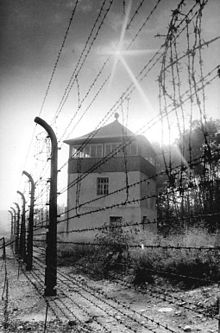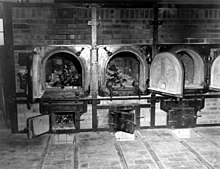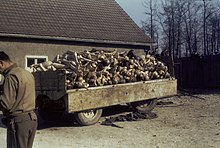Buchenwald concentration camp (German: Konzentrationslager (KZ) Buchenwald, IPA: [ˈbuːxənvalt]; literally, in English: beech forest) was a German Nazi concentration camp established on the Ettersberg (Etter Mountain) near Weimar, Germany, in July 1937, one of the first and the largest of the concentration camps on German soil, following Dachau's opening just over four years earlier.
Prisoners from all over Europe and the Soviet Union—Jews, Poles and other Slavs, the mentally ill and physically-disabled from birth defects, religious and political prisoners, Roma and Sinti, Freemasons, Jehovah's Witnesses (then called Bible Students), criminals, homosexuals, and prisoners of war—worked primarily as forced labor in local armaments factories.[1] From 1945 to 1950, the camp was used by the Soviet occupation authorities as an internment camp, known as NKVD special camp number 2.
Today the remains of Buchenwald serve as a memorial and permanent exhibition and museum.In 1937, the Nazis constructed Buchenwald concentration camp, near Weimar, Germany. Embedded in the camp's main entrance gate is the slogan Jedem das Seine (literally "to each his own", but figuratively "everyone gets what he deserves”). The camp was operational until its liberation in 1945. Between 1945 and 1950, it was used by the Soviet Union as an NKVD special camp for Germans. On January 6, 1950, the Soviets handed over Buchenwald to the East German Ministry of Internal Affairs.
The camp was to be named K. L. Ettersberg, but this was changed to Buchenwald ("beech forest"),[3] since Ettersberg carried too many associations with Goethe, who strolled through the woods (his lover Charlotte von Stein lived there) and supposedly wrote his "Wanderer's Nightsong",or, alternatively, the Walpurgisnacht passages of his Faust under the oak tree which remained in the center of the camp after the forest was cleared for its construction: this tree is the famous Goethe Oak. Quickly the fate of the oak became associated with the fate of Germany: if the one was to fall, so was the other.
Between April 1938 and April 1945, some 238,380 people of various nationalities including 350 Western Allied prisoners of war (POW)s were incarcerated in Buchenwald. One estimate places the number of deaths at 56,000.
During an American bombing raid on August 24, 1944 that was directed at a nearby armaments factory, several bombs, including incendiaries, also fell on the camp, resulting in heavy casualties amongst the prisoners[6] (2,000 prisoners wounded & 388 killed by the raid).
 Today the remains of the camp serve as a memorial and permanent exhibition and museum administered by the Buchenwald and Mittelbau-Dora Memorials Foundation, which also oversees the camp's memorial at Mittelbau-Dora.Camp commandants
Today the remains of the camp serve as a memorial and permanent exhibition and museum administered by the Buchenwald and Mittelbau-Dora Memorials Foundation, which also oversees the camp's memorial at Mittelbau-Dora.Camp commandants
SS-Obersturmbannführer: Karl-Otto Koch (1 August 1937–July 1941)
SS-Standartenführer: Hermann Pister (1942–1945)
Buchenwald’s first commandant was Karl-Otto Koch, who ran the camp from 1937 to July 1941. His second wife, Ilse Koch, became notorious as Die Hexe von Buchenwald ("the witch of Buchenwald") for her cruelty and brutality. Koch had a zoo built by the prisoners in the camp, with a bear pit (Bärenzwinger)facing the Appellplatz, the assembly square where prisoner "roll-calls" were conducted.
Koch himself was eventually imprisoned at Buchenwald by the Nazi authorities for incitement to murder. The charges were lodged by Prince Waldeck and Dr. Morgen, to which were later added charges of corruption, embezzlement, black market dealings, and exploitation of the camp workers for personal gain. Other camp officials were charged, including Ilse Koch. The trial resulted in Karl Koch being sentenced to death for disgracing both himself and the SS; he was executed by firing squad on April 5, 1945, one week before American troops arrived.[10] Ilse Koch was sentenced to a term of four years' imprisonment after the war. Her sentence was reduced to two years and she was set free. She was subsequently arrested again and sentenced to life imprisonment by the post-war German authorities; she committed suicide in a Bavarian prison cell in September 1967.
The second commandant of the camp was Hermann Pister (1942–1945). He was tried in 1947 (Dachau Trials) and sentenced to death, but died in September 1948 of a heart condition before the sentence could be carried out.The number of women held in Buchenwald was somewhere between 500 and 1,000. The first female inmates were twenty political prisoners who were accompanied by a female SS guard (Aufseherin); these women were brought to Buchenwald from Ravensbrück in 1941 and forced into sexual slavery at the camp's brothel. The SS later fired the SS woman on duty in the brothel for corruption, her position was taken over by “brothel mothers” as ordered by SS chief Heinrich Himmler.
The majority of women prisoners, however, arrived in 1944 and 1945 from other camps, mainly Auschwitz, Ravensbrück, and Bergen Belsen. Only one barrack was set aside for them; this was overseen by the female block leader (Blockführerin) Franziska Hoengesberg, who came from Essen when it was evacuated. All the women prisoners were later shipped out to one of Buchenwald's many female satellite camps in Sömmerda, Buttelstedt, Mühlhausen, Gotha, Gelsenkirchen, Essen, Lippstadt, Weimar, Magdeburg, and Penig, to name a few. No female guards were permanently stationed at Buchenwald.
When the Buchenwald camp was evacuated, the SS sent the male prisoners to other camps, and the five-hundred remaining women (including one of the secret annexe members who lived with Anne Frank, "Mrs. van Daan", real name Auguste van Pels), were taken by train and on foot to the Theresienstadt concentration camp and ghetto in the protectorate of Bohemia and Moravia. Many, including van Pels, died sometime between April and May 1945. Because the female prisoner population at Buchenwald was comparatively small, the SS only trained female overseers at the camp and "assigned" them to one of the female subcamps. Twenty-two known female guards had personnel files at the camp, but it is unlikely that any of them stayed at Buchenwald for longer than a few days.
Ilse Koch served as head supervisor (Oberaufseherin) of 22 other female guards and hundreds of women prisoners in the main camp. More than 530 women served as guards in the vast Buchenwald system of subcamps and external commands across Germany. Only 22 women served/trained in Buchenwald, compared to over 15,500 men.[13] Anna Fest was a guard at Ravensbrueck, who was later tried and acquitted. Ulla Erna Frieda Jürß was a guard at Ravensbrück, who was convicted of her crimes. Although it was highly unusual for German authorities to send Western Allied POWs to concentration camps, Buchenwald held a group of 168 aviators for two months.[15] These men were from the United States, United Kingdom, Canada, Australia, New Zealand and Jamaica. They all arrived at Buchenwald on August 20, 1944.
All these airmen were in aircraft that had crashed in occupied France. Two explanations are given for them being sent to a concentration camp: first, that they had managed to make contact with the French Resistance, some were disguised as civilians, and they were carrying false papers when caught; they were therefore categorized by the Germans as spies, which meant their rights under the Geneva Convention were not respected. The second explanation is that they had been categorised as Terrorflieger ("terror aviators"). The aviators were initially held in Gestapo prisons and headquarters in France. In April or August 1944, they and other Gestapo prisoners were packed into covered goods wagons (US: boxcars) and sent to Buchenwald. The journey took five days, during which they received very little food or water. One aviator recalled their arrival at Buchenwald:.A primary cause of death was illness due to harsh camp conditions, with starvation—and its consequent illnesses—prevalent. Malnourished and suffering from disease, many were literally "worked to death" under the Vernichtung durch Arbeit policy (extermination through labor), as inmates only had the choice between slave labor or inevitable execution. Many inmates died as a result of human experimentation or fell victim to arbitrary acts perpetrated by the SS guards. Other prisoners were simply murdered, primarily by shooting and hanging.
Walter Gerhard Martin Sommer was an SS Hauptscharführer who served as a guard at the concentration camps of Dachau and Buchenwald. Known as the "Hangman of Buchenwald", he was considered a depraved sadist who reportedly ordered Otto Neururer and Mathias Spannlang, two Austrian priests, to be crucified upside-down. Sommer was especially infamous for hanging prisoners from trees with their wrists behind their backs in the "singing forest", so named because of the screams which emanated from this wooded area.
Summary executions of Soviet POWs were also carried out at Buchenwald. At least 1,000 men were selected in 1941–2 by a task force of three Dresden Gestapo officers and sent to the camp for immediate liquidation by a gunshot to the back of the neck, the infamous Genickschuss.

The camp was also a site of large-scale trials for vaccines against epidemic typhus in 1942 and 1943. In all 729 inmates were used as test subjects, of whom 154 died.[23] Other "experimentation" occurred at Buchenwald on a smaller scale. One such experiment aimed at determining the precise fatal dose of a poison of the alkaloid group; according to the testimony of one doctor, four Russian POWs were administered the poison, and when it proved not to be fatal they were "strangled in the crematorium" and subsequently "dissected".[24] Among various other experiments was one which, in order to test the effectiveness of a balm for wounds from incendiary bombs, involved inflicting "very severe" white phosphorus burns on inmates. When challenged at trial over the nature of this testing, and particularly over the fact that the testing was designed in some cases to cause death and only to measure the time which elapsed until death was caused, one Nazi doctor's defence was that, although a doctor, he was a "legally appointed executioner. The SS left behind accounts of the number of prisoners and people coming to and leaving the camp, categorizing those leaving them by release, transfer, or death. These accounts are one of the sources of estimates for the number of deaths in Buchenwald. According to SS documents, 33,462 died. These documents were not, however, necessarily accurate: Among those executed before 1944, many were listed as "transferred to the Gestapo". Furthermore, from 1941, Soviet POWs were executed in mass killings. Arriving prisoners selected for execution were not entered into the camp register and therefore were not among the 33,462 dead listed.

One former Buchenwald prisoner, Armin Walter, calculated the number of executions by the number of shootings in the back of the head. His job at Buchenwald was to set up and care for a radio installation at the facility where people were executed; he counted the numbers, which arrived by telex, and hid the information. He says that 8,483 Soviet prisoners of war were shot in this manner.

According to the same source, the total number of deaths at Buchenwald is estimated at 56,545. This number is the sum of:
Deaths according to material left behind by the SS: 33,462
Executions by shooting: 8,483
Executions by hanging (estimate): 1,100
Deaths during evacuation transports (estimate): 13,500
This total (56,545) corresponds to a death rate of 24 percent, assuming that the number of persons passing through the camp according to documents left by the SS, 240,000 prisoners, is accurate.

No comments:
Post a Comment